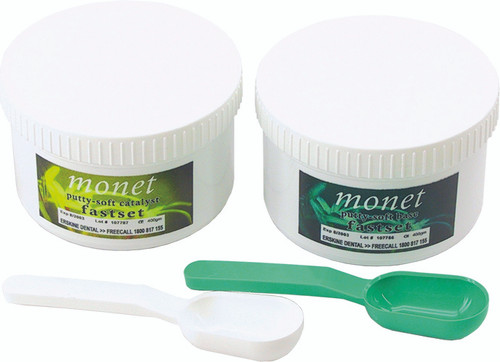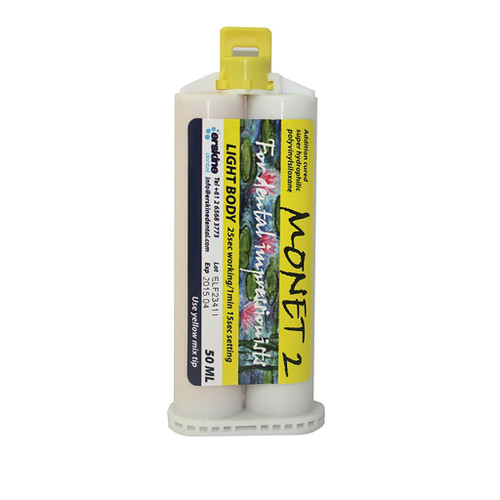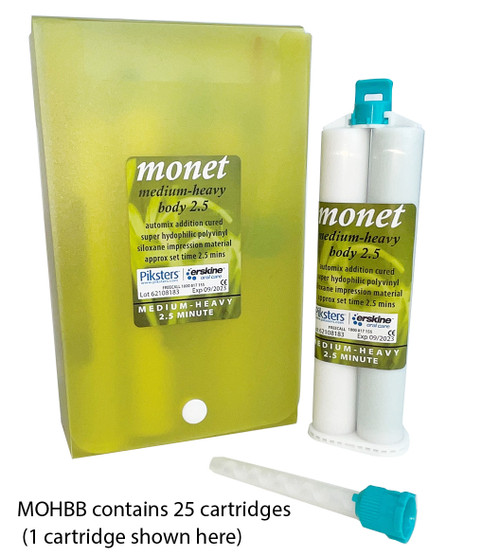Impression Materials
Capture every detail with dental impression materials
Elevate accuracy with dental impression materials, with precision and reliability that doesn’t miss any details. We offer a variety of formulations for various procedures, from routine check-ups to complex restorative treatments. Discover impression materials in dentistry that deliver ease of use, exceptional detail reproduction and patient comfort — shop at Erskine Dental.
Explore our range
Dental impression materials are essential across a wide range of clinical applications. From restorative dentistry to orthodontics, Erskine Dental’s quality materials allow clinicians to capture more accurate impressions that support predictable results. Our premium dental impression materials are perfect for:
- Crowns, bridges and veneers
- Dentures and relining
- Bite registration
- Orthodontic and implant planning
Tailored for accuracy and patient comfort
Explore our dental impression materials, including the Vinyl Polysiloxane (VPS) Take 1™ Advanced™, known for its superior performance attributes. This VPS material stands out with exceptional tear strength and hydrophilic properties, ensuring detailed impressions free of voids. Its remarkable dimensional stability also guarantees enduring accuracy.
Alongside Take 1™ Advanced™, we offer Monet 2 Automix Medium/Heavy Body Cartridges for robust impressions and Monet 2 Light Body Cartridges, ideal for capturing precise preliminary moulds.
Our lineup of dental impression materials includes rapid-setting options for patient convenience, stable materials for long-term accuracy and products designed for excellent elastic recovery to prevent tearing upon removal. Each one captures the essential fine details for accurate diagnoses and effective treatments. Whether creating moulds for crowns, bridges, dentures or orthodontic appliances, our offerings serve the diverse needs of modern practices.
Choosing and using dental putty
Dental putty is one of the most widely used impression materials, valued for its ease of handling and ability to capture detailed moulds. Unlike alginate, which is typically used for preliminary impressions, dental putty provides greater stability and dimensional accuracy, especially when paired with light body materials in a two-step impression technique.
Clinicians use putty to create impressions for crowns, bridges, dentures, whitening trays and diagnostic models. To ensure accuracy, always follow manufacturer's instructions for mixing and setting times.
Handling, storage and workflow tips
To maintain reliability and performance, proper storage and handling are key:
- Storage — Keep dental impression materials in a cool, dry environment away from direct sunlight or extreme temperatures.
- Shelf life — Most VPS and putty formulations offer excellent stability when stored correctly, with shelf life varying by product. Always check the manufacturer’s expiry date.
- Efficiency — Streamline your workflow with mixing tips, impression trays and retraction materials for soft tissue management.
- Fit verification — Use fit test materials to help confirm the accuracy of crowns and bridges before final cementation, reducing the likelihood of remakes.
Shop dental impression materials at Erskine Dental
Equip your practice with the finest dental solutions from Erskine Dental. Buy dental putty and other impression materials today and enhance the quality of your dental care services.
Contact us for pricing and bulk orders. Learn more about what we offer, access valuable resources and take advantage of our super specials by exploring our website. For more innovative dental solutions, explore our range of Piksters® Dental products for professionals.
FAQs
What material is used for dental impressions?
A variety of materials are used for dental impressions, including silicone-based materials for their flexibility and accuracy, alginate materials for preliminary impressions and specialised VPS formulations like Take 1™ Advanced™, which offers unique features for enhanced performance.
What is dental putty, and how does it differ from other impression materials?
Dental putty is a thick, silicone-based impression material used to capture accurate moulds of teeth and gums. Compared to alginate, putty offers greater dimensional stability and is less prone to distortion. It is often used with light body material in a “putty-wash” technique to achieve both strength and fine detail.
What is the most stable dental impression material?
VPS impression materials are renowned for their exceptional dimensional stability, making them among the most stable options available for dental impressions. This stability ensures that impressions remain accurate over time, free from distortion due to dimensional changes or temporary deformation.
What is the most widely used dental impression material?
Alginate materials are among the most widely used for dental impressions, valued for their ease of use and suitability for a variety of applications, including preliminary impressions. However, silicone-based dental impression materials, including VPS like Take 1™ Advanced™, are also popular choices for their enhanced precision and performance. They have excellent dimensional stability that resists distortion, leading to better treatment outcomes.
How do I choose the right impression material for my practice?
The choice depends on the procedure. Alginate is suitable for preliminary impressions, while VPS and putty are recommended for final impressions requiring precision. For occlusal records, use dedicated bite registration materials.
What is the difference between a light and a heavy body cartridge?
The primary difference between light and heavy body cartridges lies in their viscosity and intended use during the impression process. Light body cartridges, such as the Monet 2 Light Body Cartridges, have a lower viscosity. This makes them ideal dental impression materials that flow into narrow spaces and capture fine details. They're often used for the wash or final impression in two-step impression techniques.
On the other hand, heavy body cartridges, exemplified by Monet 2 Automix Medium/Heavy Body Cartridges, have a higher viscosity and are used to create the tray portion of the impression. Their thicker consistency strongly supports the lighter, more detailed wash material.
How should dental impression materials be stored?
All dental impression materials should be stored in a cool, dry place away from direct sunlight. Avoid leaving cartridges or tubs in areas with fluctuating temperatures, as this can affect consistency and setting times.
What is the shelf life of dental impression materials?
Shelf life varies by brand and formulation, but if stored correctly, it is generally one to three years. Always check the expiry date printed on the packaging before use.
What other impression material do you offer?
Erskine Dental stocks a wide range of impression solutions, including denture relining and repair products, impression trays, laboratory materials, mixing tips and retraction products.
















